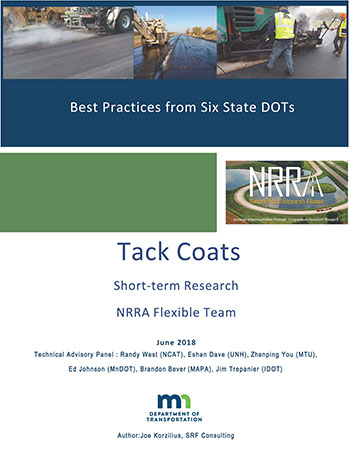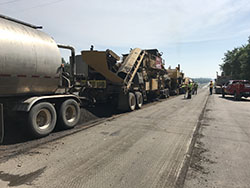NRRA Newsletter: December 2018
Tack Coats Get Some Respect
It could be said that Tack Coats are the Rodney Dangerfield of the paving industry: they get no respect. It’s a shame really, because tack coats are vital to the longevity of asphalt pavements. How vital?
“I suspect we lose 25% of our potential pavement life on about one-third to one-half of our bituminous pavement due to no bond,” said Erland Lukanen, retired MnDOT engineer and pavement expert.
| For more information about Tack Coats, check out the Flexible Team's Research Page. |
 |
The fact is, if the tack coat isn’t applied correctly, there is no bond. And if there is no bond, the carefully designed, thoughtfully mixed asphalt pavement doesn’t have the strength it needs. The pavement layers will only perform if they are bonded together with tack, says Jerry Geib, research operations engineer for MnDOT. If that doesn’t happen, the deflection is much worse.
If the HMA deflects a lot, the base can fail on a shear plane, and then you get ruts and fatigue in the asphalt layer. Geib says when he has seen forensics on a failed asphalt cell, often as not, the failure was because of a bad tack coat.
Here are four things to consider when applying tack coats.
- Uniformity: Geib says a uniform coat of tack is vital, and state DOTs need to understand that.
- Wheels: The joke about tack coats is “What do tack coats do? They coat the tires of trucks.” That’s because, once the tack coat is down, you often get trucks running over it, picking up the tack on their tires and getting the surface dirty. When that happens, you lose the bonding quality of the tack, and then you risk the aforementioned deflection and failure. Even worse, says Geib, often the tack that gets picked up by the tires are right in the wheel path of the road where you really need that bond for strength. There are new products, says Geib, that are non-tracking tack that set in a couple of minutes. These have great potential, but he is also concerned about brittleness.
- Stability: It’s important to remember that tack breaks. That means that, if you’re not careful and attentive, the asphalt and the water can separate in the truck. That creates clogs that are very bad.
- Spray Pavers: One new tool that has proven to be very useful is the spray paver. It’s a paver that has tack coat nozzles installed in front of the screed. These nozzles spray the tack right in front of the HMA as it goes down. Geib uses words like “outstanding” and “tremendous” when talking about spray pavers. The only upshot is they are twice the cost of regular pavers, so contractors might not always have them available for your next job.
The lesson here is: Pay attention to tack. If you give some attention and respect to the application of tack, you can forego possible pavement failures in the future.
NRRA at TRB
As usual, we have quite few NRRA members presenting at the TRB Annual Meeting for 2019. Below is a partial list of alliance members who are presenting. The full descriptions of their presentations, including dates and times, can be found here. We also have a booth (#1140), so please drop by and visit with us.
Imad Al-Qadi, University of Illinois at Urbana–Champaign
Manik Barman, University of Minnesota Duluth
Steve Cross, ARRA
Jason Wielinski, ARRA
Shongtao Dai, MnDOT
Eshan Dave, University of New Hampshire
John Donahue, MoDOT
Glenn Engstrom, MnDOT
Majid Ghayoomi, University of New Hampshire
Bernard I. Izevbekhai, MnDOT
Jennifer Jacobs, University of New Hampshire
Mike Leegard, MnDOT
Mihai Marasteanu, University of Minnesota
Ken Maser, Infrasense
Aleksey Khamzin, Infrasense
Angel Mateos, Univ. of California Berkeley
Soheil Nazarian, University of Texas El Paso
Hasan Ozer, University of Illinois at Urbana–Champaign
Kerrie Schattler, Bradley University
Larry Scofield, American Concrete Pavement Association
Eyoab Zegeye Teshale, MnDOT
Ben Worel, MnDOT
Zhanping You, Michigan Tech University
Agency Project Profile: Old Roads, Few Records
There’s no substitute for keeping good records, but as often as not, rehabilitating old roads involves a lot of guesswork due to incomplete or non-existent records regarding their construction.
That was the challenge faced by alliance members Midstate Reclamation and Trucking and American Engineering Testing in South Dakota. Two old roads, County Road 23 and County Road 31 needed rehabilitation but the construction team wasn’t sure what they were dealing with below the surface.
The counties wanted to save money on the project, so they needed to know if they had the right conditions for cold in-place recycling. The roads were 8 miles long and 12 miles long, respectively, and they appeared to be asphalt on top of an old gravel road.
“The counties didn’t know what they had out there,” said Jacob Michalowski, senior engineer with AET. Their  CIPR plan involved milling off the top 4 inches of old asphalt, recycling the material, paving the road and finishing with a double chip seal. With little known about the subgrade, the construction team was concerned about its strength. Would it be strong enough to support the CIPR train (milling machine, mixer, paver and compactors)?
CIPR plan involved milling off the top 4 inches of old asphalt, recycling the material, paving the road and finishing with a double chip seal. With little known about the subgrade, the construction team was concerned about its strength. Would it be strong enough to support the CIPR train (milling machine, mixer, paver and compactors)?
So began an extensive up-front investigation using ground penetrating radar, a falling-weight deflectometer, pavement cores and soil borings. The GPR and FWD tests showed them locations—soft areas—for cores and borings. The GPR they used involved the 2 GHz antenna and extended 18-24 inches into the road to measure the bituminous pavement and aggregate base layer thicknesses.
The up-front battery of tests did reveal some soft areas in the subgrade, areas where the CIPR train might plunge through. To mitigate this, said Michalowski, they did cement stabilization to these areas prior to the CIPR process.
“The great part about those tests is they were able to give the county an actual visual representation of the depths of things,” said Dan Schellhammer, vice president of Midstate.
That solution involved grinding the roadway to a depth of 12 inches and mixing the existing soil with cement power. The mix design involved combining the soil and cement together to create a 12-inch thick patch. The challenge was to build a soil/cement patch with optimal strength—strong enough to support the CIPR train but not so strong that it would get brittle and create reflective cracking.
The next surprise came when the CIPR process began. They planned to take off the top four inches of the five-inch thick asphalt surface. They soon discovered that it was five inches of asphalt down the middle of the road, but near the edges of the pavement there were spots that were only two to three inches thick.
The CIPR train did punch through on those thin sections and some of the base started getting in the mix. Midland responded by increasing the oil in the mix and that worked.
With the twin goals of saving money and rehabilitating a roadway that would last, how did these projects fare? According to Schellhammer, the project involving County Road 31 was projected to cost $1.9 million using regular HMA, and using CIPR brought the cost down to $1.3 million.
In fact, says Schellhammer, Brown County is going to repeat this process in 2019 on a couple of roads. The neighboring county saw the results and is also going try this out on some roads in 2019.
These roads were reconstructed late in the summer, so their first test was harvest season, which puts a great deal of strain on pavements. So far, the counties are very happy with the performance. The next challenge will be, of course, winter and spring thaw.
In the “lessons learned” column, Michalowski has a couple of items. First, the less information you have about a road and its construction, the more important it is to do a good pavement investigation process up front. Second, investigate the depth of the pavement all across the road, especially near the edges, so you don’t get surprised.
Research Pays Off January
Our webinar series is cancelled for January due to the TRB Annual Meeting happening at the same time. See you on February 19 for our regular scheduled series. As always, if you have idea you would like to present, or want to see presented, contact our producer.


